Beetles - Weevils
BEETLES - ALL
List of Weevils :
Acorn Weevil - Nut Weevil ???
Curculio glandium, Curculio nucum ???
Date
20.08.2012
Sighting
Found in an illuminated moth trap.
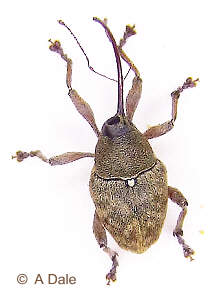

These are two very similar weevils that are vitually impossible to tell apart without resorting to microscopic examination and so I include both names. The long 'snout' (rostrum) is what immediately caught my eye. This is actually an adapted mouth structure and is equipped with tiny mandibles at the tip, used to tunnel into young green acorns and nuts. The female then deposits an egg in the tunnel. The larva will feed for some weeks within the nut and may cause the nut to drop prematurely. But, the larva will remain inside and overwinter until pupation and hatching the following spring.
Curculio glandium is said to favour acorns while C. nucum favours hazel nuts. Since I found this specimen within 12 feet of Hazel trees, I was quite confident that it would be C. nucum. However learned opinion suggests that certain characterstics make it more likely to be C. glandium - and the nearest Oak trees to my property are 1km away!
Body length of this specimen, to the base of the rostrum, was 6mm but size can apparently range from 4 to 9mm, depending on species, age and gender. In general, C. glandium is larger than C. nucum. However a female C. nucum can be larger than a male C. glandium - not very helpful!
no common name
Ceutorhynchus napi
This is a tiny weevil (just over 3mm) which I would have missed had it not been silhouetted on the rim of an unripe seed pod of the cruciferous plant Lunaria annua (the domestic escape, Honesty).
Date
04.08.2006
Sighting
On seed pod of garden Honesty.
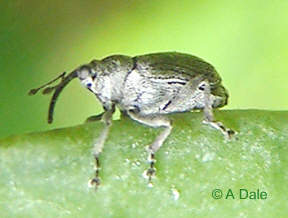

It is fortunate that certain insect species favour certain groups of plants since this helps to narrow down the identification options.
However, cabbages and other brassicas are also cruciferous and this means that this weevil can be targeted as an agricultural pest - the larvae live within the plant stems causing them to deform and the adults suck the stem juices - both reducing plant vigour.
Clay-coloured Weevil
Otiorhynchus singularis ?
This is a common species, 6 to 8mm in length, and is widely found throughout Lincolnshire.
The reason for the question mark after the species name is that there are 18 different Otiorhynchus species in the UK and many more in Europe, that look confusingly similar to the naked eye - one of them being the notorious, darker Vine Weevil, O. sulcatus, much hated by gardeners. The specimen seen here is paler, slightly smaller than the Vine Weevil and has a 'fuzz' of short hairs covering its elytra (wing cases).
Date
Sighting
27.04.2010
Found on a white painted wall.
Although it may not earn the same notoriety as the Vine Weevil this weevil is suggested to have a wide range of food plants from conifers, to brambles in hedgerows and currant and rasberry plants in the garden (and so is sometimes called the Currant or Rasberry Weevil). The adults, active from March through to September, eat leaves and shoots, while the larvae nibble roots.

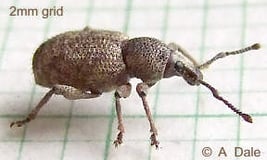
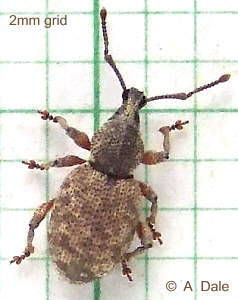

The weevils fall prey to parasitism by the Ichneumonidae, braconid wasps such as Pygostolus fulcatus.
Figwort Weevil
Cionus scrophulariae
Date
30.06.2004
Sighting
On Water Figwort in ditch opposite front door.
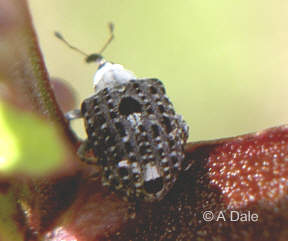

At only 4.5 mm in length it could be easily overlooked. But, very active. Over the course of 14 days I was able to find it on various parts of the plant before a heavy thunderstorm presumably washed it away.


At the end of the long snout are some very effective mandibles which are able to bore deep into the heart of the figwort fruits.
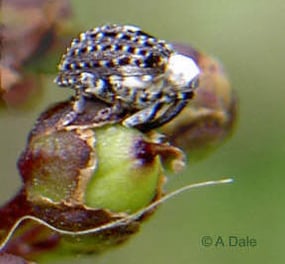

Then 8 days later I noticed about 8 little dark grey slugs on the plant but gave them no further thought. Until after four days they were considerably larger - and obviously not slugs. My first thought was that they might be sawfly larvae. But I am assured that they are in fact, Figwort Weevil larvae.
And only four weeks after that there were five new adults on the same plant stem - which suggests a 2nd generation but a much faster regeneration than I would have expected.
21.07.2004
Larvae found on same plant.
17.08.2004
Five new adults found on same stem of same plant.
Adult found (surprisingly) on the inflorescence of Garlic Mustard, Allioria petiolata.
26.07.2006
17.05.2007
One adult found on Water Figwort plant, hours before the plant was trashed in a ditch cleaning operation!
I had been keeping an eye on the Water Figwort hoping to see some Mullien moth caterpillars. I noticed a grey 'bird dropping' on one of the flowers - but a closer look revealed a little grizzled weevil. It is a sad fact that I now take a keen interest in bird droppings! Textbook images portray it as rather darker but in sunlight it was really quite light.
no common name
Liophloeus tessulatus
Whereas most weevils seem capable of scampering around with some agility, this species is rather slow and cumbersome. This one stood quite placidly by the millimetric scale for me. And with only very rudimentary wings tucked under its elytra, they have even given up the ability to fly.
None of which appears to have hindered its dispersal throughout the UK. It is to be found in mountainous regions as well as low damp meadows.
Date
Sighting
01.08.2005
Found on Creeping thistle.
Strangely, at low levels, the females are able to reproduce parthenogenically without male intervention but at higher altitudes where partners might appear to be fewer in number and more difficult to find, the weevils resort to 'normal' bi-sexual reproduction.
With their wide range of habitats, it is no surprise that can survive on a wide range of food plants, from coltsfoot to ivy. The specimen in the upper image was found on Creeping thistle, Cirsium arvense, and that in the lower image was found on a verge rich in Cow Parsley and Hogweed.

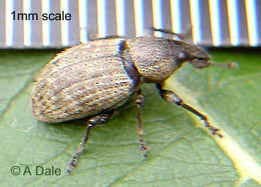
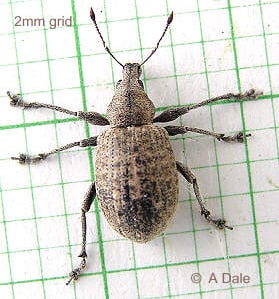

This species can vary in length, from 'eye line to end of elytra', from 7 to 11mm. The colouring and size of the Vine weevil, Otiorhinchus sulcatus is similar but that is distinguished by the basal segment of the antenna being longer than the width of the pronotum (the broad area just behind the head). The Vine weevil also has pronounced 'spurs' on its femurs whereas those on L. tessulatus are reduced to small lumps on the underside of the femurs.
Found amongst Cow Parsley and Hogweed on roadside verge.
17.05.2008
'Green Nettle Weevil'
Phyllobius pomaceus
Many plant eating insects can be regarded as pests but an insect which in both larval and adult form eats nettles should appeal to all - well, apart from its looks. The larvae spend their time below ground feeding on nettle roots.
Date
Sighting
04.06.2003
On nettles by meadow western hedge.
13.05.2004
3 on nettles by roadside verge.
11.05.2005
First of the season seen on nettles by hay meadow western hedge.
The irridescent sheen of the adult comes from a coating of green scales which covers the black body. These can be lost and results in a rather 'worn', patchy appearance.
Overall length was about 8mm.

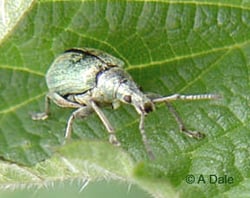

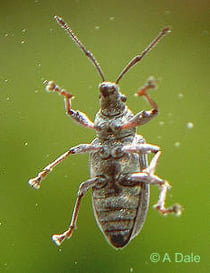
The lower image illustrates how the legs of beetles and weevils are positioned differently to butterflies, moths and flies, etc. The legs of all the insects originate from the thorax and in the flies, etc. they are bunched up in front of the abdomen. But, in the case of the beetles, the underside of the thorax extends like a shield under the front of the abdomen and allows the legs to be more equispaced.
This is probably an evolutionary requirement to ensure better weight distribution in these bulkier insects.
'Small Nettle Weevil'
Neydus quadrimaculatus
These were tiny. No more than 2.5mm in length.
I am sure that I would have missed one on its own. But two just about warranted a closer look. And its not often one sees 2.5mm, six legged elephants!
Date
30.05.2004
Sighting
On stinging nettles by Meadow hedge. TF 305 660.

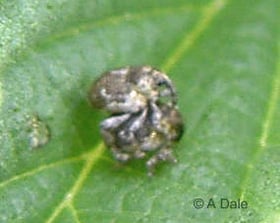
This larger than life image reveals quite prominent femora - which implies a jumping weevil? But I was not aware of that feature at the time and so did not test that theory.
Pea Weevil
Sitona lineatus
The Pea Weevil is definitely considered a pest in the farming world. The larvae, living below ground nibble the roots and root nodules of the pea plant and above ground the adults reduce the vigour of the plant by eating the leaves. This leads farmers to pesticide spray their crops once or twice a season.
This particular specimen was found in a permanent pasture containing clover and lesser trefoil which the species will fall back on in the absence of its prime diet - which happened to have been growing in the adjacent field the previous year.
Date
28.03.2005
Sighting
Found active in hay meadow on a warm sunny day.


Because of its leaf nibbling diet the Sitona genus (of which there are 20 species found in the UK) has no need of the long probing snout commonly associated with weevils in general.
This one was just over 5mm in length and was active on a warm March day.
Red 'Rumex' weevil
Apion frumentarium
There are quite a large group of Apion weevils most of which are dark in colour. But there are half a dozen red species which favour the Rumex group of plants, e.g., docks and sorrels, and this one was found on the back of a leaf of Broad-leafed Dock, Rumex obtusifolius, happily munching away on the centre rib.
When identifying insects, size plays a significant role in ruling out unlikely candidates - and I soon found that my initial estimate was 'questionable'. So a second specimen was sought which could be more accurately measured.
And then the fun started.
Date
Sighting
In the wild this weevil seems to spend much of its time upside down on the underside of leaves. So instead of calmly sitting on my piece of graph paper to have its details recorded, it would insist on clambering up onto the underside of the plastic container I was using to constrain it.
In the end I had to hold the container above my head and photograph it from underneath and hope the weevil didn't drop off in the process.
But, all was well and it was safely returned to a lush green dock.
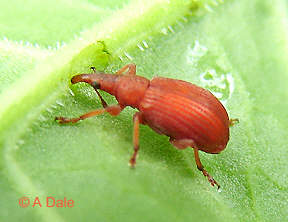

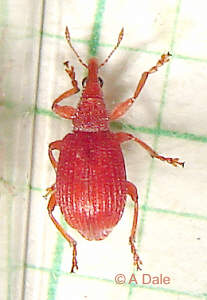

Some weevil species have exceptionally long, thin, curved 'snouts' (rostrums) which can exaggerate their overall size. The rostrums of some of the Curculio species are almost as long as the rest of the body. To get around this, a convention has been adopted to measure weevils from the rear of the elytra to an imaginary line drawn in front of their eyes. On that basis this specimen is just over 4mm long.
Found on Large-leaved Dock on roadside verge.
29.09.2006
.......previously A. miniatum
Willow Gall Weevil
Curculio / Archarius salicivorus
This is a tiny little weevil, no more than 2.5mm long. Weevils are measured from the eye line to the end of the body omitting the curved snout which can be, sometimes, difficult to measure accurately.
As befits its common name, it was found on Salix caprea (Willow). A side view of it would reveal that it has a contrasting pale underside.
Date
04.05.2009
Sighting
Found on Kilmarnock Willow, Salix caprea.
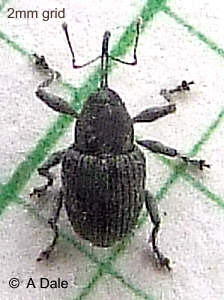

The weevil lays its eggs in willow leaf galls where the larva will predate upon the grub of the gall causer - normally a small fly.
30.05.2004
Found on Kilmarnock Willow. TF 305 662.
